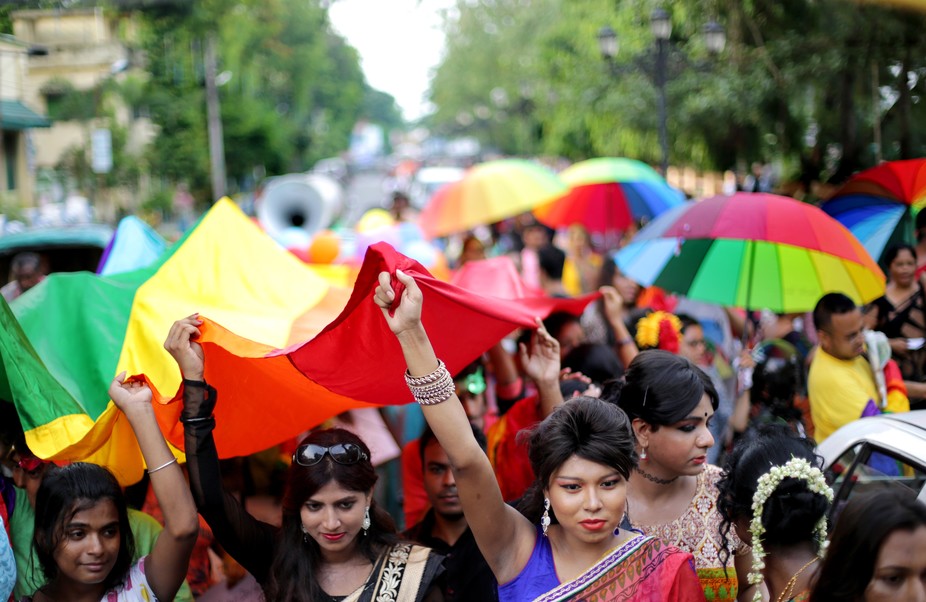The British Empire’s Homophobic Legacy Could Finally Be Overturned in India
SEXUALITIES, 4 Sep 2017
Ibtisam Ahmed – The Conversation
1 Sep 2017 – In a landmark ruling, India’s Supreme Court has confirmed an individual’s right to privacy – including sexual orientation – under the country’s constitution. The ruling on August 24 offers new hope for the LGBTQ+ community in India, still living under the homophobic legacy of the British Empire which criminalised same-sex relationships. A formal judgement on the law, known as Section 377, is still pending and the hope is that the court will repeal this toxic colonial hangover.
This legacy dates back 157 years to a dark part of imperial history. In 1860, the British Raj – the empire in India – had been in place for three years. The British East India Company had given way to crown control after the 1857 Sepoy Rebellion and justified its conquest with a promise of bringing “civilisation” to its colonies. Part of this civilising rhetoric was tied in with reforming the ways in which desire and love were practised and accepted.
At the time, a multitude of social norms existed within the borders of the Indian subcontinent largely influenced by religion, geography and occasionally by ethnicity. Suggesting there was a monolithic and singular attitude to anything was misleading. In contrast, there was a rich diversity in the ways in which sexuality was understood. Even in socially conservative areas, same-sex intimacy was simply a part of life.
httpv://www.youtube.com/watch?v=iplGW7MNNmI
Awadh, in modern-day Lucknow, had a ruler who would practice living as the opposite gender at times, including changing sexual partners. Bengali novels from the late 19th century such as Indira describe lesbian relationships. Texts such as the Kama Sutra contain advice for consensual same-sex intercourse. And Sufi Muslim texts in East India explicitly mention homosexual male romance.
This clashed with the British crown’s idea of how a society should be. In a system dictated by Victorian Christian morality, any form of intimacy that was not geared towards having and raising children was unacceptable. Homosexual desire was the worst of these offences.
With such a rigid vision in mind, the empire implemented Section 377 in the Raj. The law made it a criminal offence to engage in any form of “unacceptable carnal desire”. Perpetrators could be jailed, given a heavy fine, or both. The law was exported to Australia, South-East Asia and African British colonial outposts as well.
No united opposition
Historically, Section 377 did not explicitly target homosexuals. It was meant to deter any type of sex that was not for the purposes of having children. This theoretically included protected sex between a heterosexual couple and also effectively outlawed forms of birth control. But in practice, this proved impossible to police, and over the decades, the implementation of the law came to focus purely on homosexual desire.
India’s diversity of sexual expression proved to be a weakness against this relentless campaign. The lack of a united narrative about homosexuality across India meant that there was no singular dissenting voice against the forced implementation of Section 377 in 1860. This was combined with a powerful propaganda machine which linked British military success with rigid masculinity and the Indian conquest with femininity among men. In particular, historical pamphlets and writings on the military victory in 1857 and the earlier victory in Bengal (the Battle of Plassey) made clear reference to the “inferiority of the effeminate Indians”.
There was also a concentrated and largely successful effort to alienate and undermine the agency of women and of gender non-binary communities, such as Hijra – a third gender identity who are born male or intersex but present as feminine in dress. Today, Hijra are recognised and protected by law in India, Pakistan and Bangladesh.
This resulted in the firm establishment of legalised homophobia (and also misogyny and wider queer discrimination) in the subcontinent over the course of the Raj. By the time the Indian independence movement began to gain viable momentum in the 20th century, the challenges to Section 377 had died out and any narrative of queer emancipation was erased from both sides of the debate.
Homophobic laws retained
At the moment of their birth, Pakistan and India moved towards new constitutions and penal codes, yet many remnants of colonial control remained. Section 377 was retained in their respective statute books. When Bangladesh gained its independence from Pakistan in 1971, it was maintained there as well. It is still maintained in all three countries of the erstwhile Raj – India, Bangladesh and Pakistan.
In fact, of the 72 countries of the world where homosexuality is illegal today, 36 punish homosexuality due to some version of 377. It is a toxic hangover which makes the 52-strong Commonwealth of Nations the most homophobic global block of countries.
As the UK celebrates 50 years of progress for LGBT rights, 36 countries in the Commonwealth criminalise same-sex acts. Our work continues. pic.twitter.com/05ArrPwSVn
— The Commonwealth Equality Network (@CWEquality) July 29, 2017
Two key commemorations of British history are being marked in 2017. The 50th anniversary of the 1967 Sexual Offences Act, which partially decriminalised homosexual sex between consenting adults in Britain, and the 70th anniversary of the partition of India and Pakistan, which brought British imperial rule on the Indian subcontinent to an end. Both anniversaries are being celebrated as a triumph of progress and equality.
The UK, Pakistan and India are all correct to celebrate the long journeys they have taken. But it is vital that marginalised voices are heard, too. To confine colonialism to the history books, all of its legacies must be dealt with and erased completely. India’s Supreme Court could be on the way to making this happen. A petition is in the process of being submitted in the Bangladeshi Supreme Court but no progress has been reported, and there is no explicit case in Pakistan as of yet. Until this is redressed, there can be no true freedom.
_________________________________________
 Ibtisam Ahmed – Doctoral Researcher, Faculty of Social Sciences, University of Nottingham
Ibtisam Ahmed – Doctoral Researcher, Faculty of Social Sciences, University of Nottingham
Republish The Conversation articles for free, online or in print, under Creative Commons license.
Go to Original – theconversation.com
DISCLAIMER: The statements, views and opinions expressed in pieces republished here are solely those of the authors and do not necessarily represent those of TMS. In accordance with title 17 U.S.C. section 107, this material is distributed without profit to those who have expressed a prior interest in receiving the included information for research and educational purposes. TMS has no affiliation whatsoever with the originator of this article nor is TMS endorsed or sponsored by the originator. “GO TO ORIGINAL” links are provided as a convenience to our readers and allow for verification of authenticity. However, as originating pages are often updated by their originating host sites, the versions posted may not match the versions our readers view when clicking the “GO TO ORIGINAL” links. This site contains copyrighted material the use of which has not always been specifically authorized by the copyright owner. We are making such material available in our efforts to advance understanding of environmental, political, human rights, economic, democracy, scientific, and social justice issues, etc. We believe this constitutes a ‘fair use’ of any such copyrighted material as provided for in section 107 of the US Copyright Law. In accordance with Title 17 U.S.C. Section 107, the material on this site is distributed without profit to those who have expressed a prior interest in receiving the included information for research and educational purposes. For more information go to: http://www.law.cornell.edu/uscode/17/107.shtml. If you wish to use copyrighted material from this site for purposes of your own that go beyond ‘fair use’, you must obtain permission from the copyright owner.
